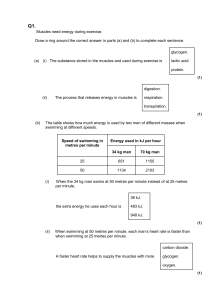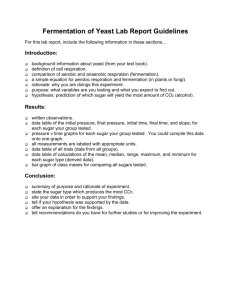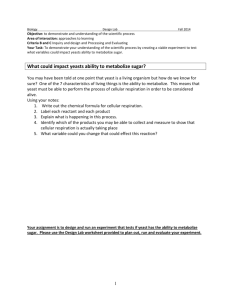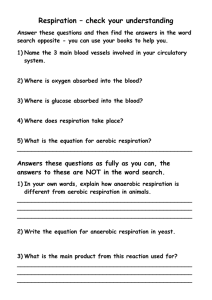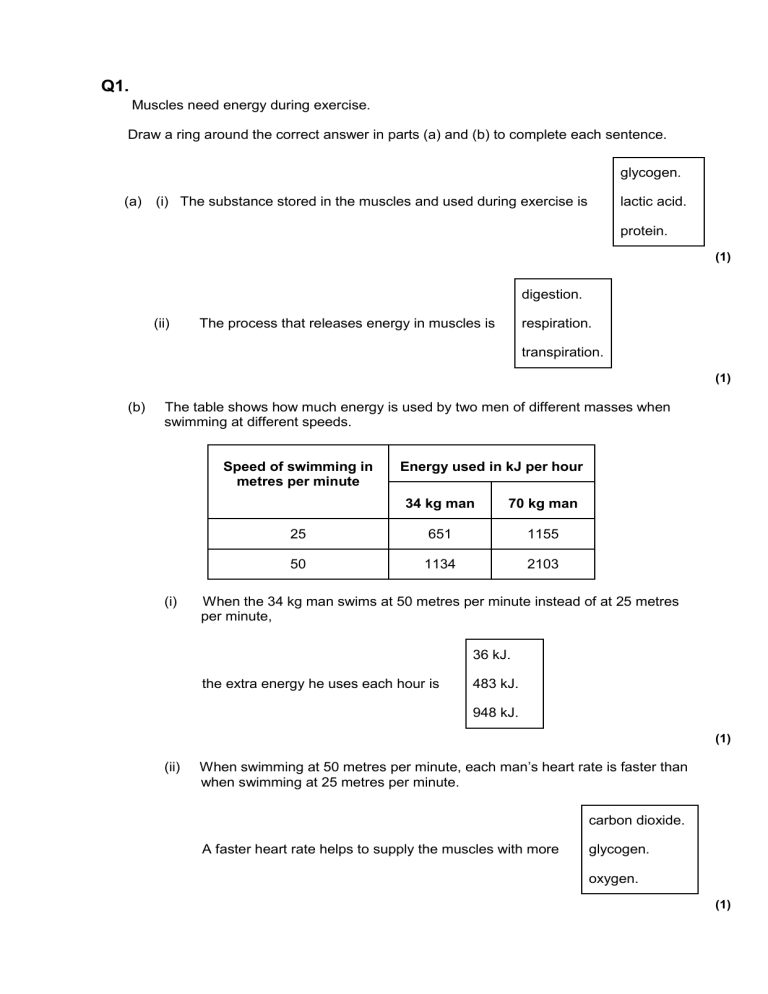
Q1. Muscles need energy during exercise. Draw a ring around the correct answer in parts (a) and (b) to complete each sentence. glycogen. (a) (i) The substance stored in the muscles and used during exercise is lactic acid. protein. (1) digestion. (ii) The process that releases energy in muscles is respiration. transpiration. (1) (b) The table shows how much energy is used by two men of different masses when swimming at different speeds. Speed of swimming in metres per minute (i) Energy used in kJ per hour 34 kg man 70 kg man 25 651 1155 50 1134 2103 When the 34 kg man swims at 50 metres per minute instead of at 25 metres per minute, 36 kJ. the extra energy he uses each hour is 483 kJ. 948 kJ. (1) (ii) When swimming at 50 metres per minute, each man’s heart rate is faster than when swimming at 25 metres per minute. carbon dioxide. A faster heart rate helps to supply the muscles with more glycogen. oxygen. (1) constrict. (iii) During the exercise the arteries supplying the muscles would dilate. pump harder. (1) (c) When a person starts to swim, the breathing rate increases. Give one way in which this increase helps the swimmer. ___________________________________________________________________ ___________________________________________________________________ (1) (Total 6 marks) Q2. Paula is training for a marathon. When she runs, her heart beats faster than it does when she is resting. Complete the sentences, using words from the box. blood breathe heat carbon dioxide nitrogen oxygen glucose respire When she is running, Paula‘s muscle activity increases. To do this, her muscle cells ______________________ at a faster rate to give her more energy. Her muscles need to be supplied with _____________________ and _______________________________ more quickly. Her heart beats faster to increase the flow of ________________________ which carries the products ______________________________________________ and ______________________________ away from her muscles. (Total 6 marks) Q3. One factor that may affect body mass is metabolic rate. (a) (i) What is meant by metabolic rate ? ______________________________________________________________ ______________________________________________________________ (1) (ii) Metabolic rate is affected by the amount of activity a person does. Give two other factors that may affect a person’s metabolic rate. 1. ____________________________________________________________ ______________________________________________________________ 2. ____________________________________________________________ ______________________________________________________________ (2) (b) Predicted early death is the number of years that a person will die before the mean age of death for the whole population. The predicted early death of a person is affected by their body mass. Scientists have calculated the effect of body mass on predicted early death. The graph shows the results of the scientists’ calculations. Ideal body mass The number of times above or below ideal body mass is given by the equation: In the UK the mean age of death for women is 82. A woman has a body mass of 70 kg. The woman’s ideal body mass is 56 kg. (i) Use the information from the graph to predict the age of this woman when she dies. ______________________________________________________________ ______________________________________________________________ ______________________________________________________________ Age at death = ___________ years (2) (ii) The woman could live longer by changing her lifestyle. Give two changes she should make. 1. ____________________________________________________________ ______________________________________________________________ 2. ____________________________________________________________ ______________________________________________________________ (2) (Total 7 marks) Q4. (a) Use words from the box to complete the equation for aerobic respiration. alcohol glucose ______________ + oxygen lactic acid water carbon dioxide + ______________ (+ energy) (2) (b) Some students investigated the effect of temperature on the rate of aerobic respiration in earthworms. The diagram shows the apparatus the students used. When the tap is closed, the bead of liquid moves to the left as the earthworms take in oxygen. The students put the test tube into a water bath at 20°C for 10 minutes. They left the tap open during this time. Why did the students put the test tube in the water bath at 20°C for 10 minutes? Tick ( ) one box. Because the air contains more oxygen at 20°C. Because the air contains less carbon dioxide at 20°C. So the earthworms’ body temperature would change to 20°C. (1) (c) The students then: • closed the tap • started a stopwatch • recorded the position of the bead of liquid every 2 minutes for 10 minutes • repeated the experiment at 10°C. The graph shows the students’ results. Time in minutes (i) How much oxygen did the earthworms take in during the 10 minutes at 20°C? Use information from the graph to work out your answer. ______________________________________________________________ ______________________________________________________________ ______________________________________________________________ Volume of oxygen taken in = ___________________ mm3 (2) (ii) The earthworms took in this volume of oxygen in 10 minutes. Use your answer from part (c)(i) to calculate how much oxygen the earthworms took in each minute. ______________________________________________________________ ______________________________________________________________ Volume of oxygen taken in = _______________________ mm3 per minute (1) (iii) The earthworms took in less oxygen each minute at 10°C than they took in at 20°C. Explain why. ______________________________________________________________ ______________________________________________________________ ______________________________________________________________ ______________________________________________________________ (2) (d) When drawing the line on the graph for the experiment at 10°C, the students ignored the reading at 8 minutes. (i) Suggest why they ignored the reading at 8 minutes. ______________________________________________________________ ______________________________________________________________ (1) (ii) One student suggested they should repeat the experiment twice more at each temperature. How would repeating the experiment improve the investigation? ______________________________________________________________ ______________________________________________________________ (1) (Total 10 marks) Q5. (a) Yeast cells can respire anaerobically. The equation for anaerobic respiration in yeast is: glucose alcohol + carbon dioxide (+ energy) Give one way in which anaerobic respiration in yeast cells is different from anaerobic respiration in human muscle cells. ___________________________________________________________________ ___________________________________________________________________ (1) (b) Yeast can use other types of sugar instead of glucose. Some scientists investigated the effect of three different types of sugar on the rate of anaerobic respiration in yeast. The scientists: • used the apparatus shown in Diagram 1 with glucose sugar • kept the apparatus at 20 °C • repeated the investigation with fructose sugar and then with mannose sugar • repeated the investigation with water instead of the sugar solution. Diagram 1 (i) Give two control variables the scientists used in this investigation. ______________________________________________________________ ______________________________________________________________ (2) (ii) The graph shows the scientists’ results. Time in minutes From this information, a company decided to use fructose to produce alcohol and not mannose or glucose. Explain the reason for the company’s choice. ______________________________________________________________ ______________________________________________________________ ______________________________________________________________ ______________________________________________________________ (2) (Total 5 marks) Mark schemes Q1. (a) (i) glycogen 1 (ii) respiration 1 (b) (i) 483 kJ 1 (ii) oxygen 1 (iii) dilate 1 (c) supplies more / a lot of oxygen or removes more carbon dioxide or release more energy / faster respiration 1 [6] Q2. (a) respire 1 2 blood 1 2 [6] Q3. (a) (i) rate of chemical reactions (in the body) 1 (ii) any two from: • heredity / inheritance / genetics • proportion of muscle to fat or (body) mass allow (body) weight / BMI • age / growth rate • gender accept hormone balance or environmental temperature ignore exercise / activity 2 (b) (i) 77 correct answer with or without working gains 2 marks allow 1 mark for 70 / 56 or 1.25 or 5 2 (ii) increase exercise accept a way of increasing exercise 1 reduce food intake accept examples such as eat less fat / sugar allow go on a diet or take in fewer calories ignore lose weight ignore medical treatments such as gastric band / liposuction 1 [7] Q4. (a) LHS – glucose 1 RHS – water allow H2O / H20 1 (b) so the earthworms’ body temperature would change to 20°C 1 (c) (i) 56 or 55 or 54 if incorrect answer given accept 60 - 5 for 1 mark or 60 – 6 for 1 mark or 60 – 4 for 1 mark 2 (ii) one-tenth of answer to (c)(i) eg 5.5 1 (at 10°C / lower temperature): lower rate of respiration allow chemical reactions slower or enzymes less active ignore breathing do not allow anaerobic 1 worms less active / worms release less energy / worms use less energy 1 (d) (i) anomalous result / not in line with other data / does not fit the pattern 1 (ii) more representative / more reliable / can check ‘repeatability’ / see if get similar values / identify anomalies ignore valid / more fair ignore reproducible ignore ‘to remove’ anomalies do not accept more accurate or more precise 1 [10] Q5. (a) in yeast: ’it’ equals yeast makes alcohol / makes CO2 / does not make lactic acid do not allow uses / involves alcohol / CO2 1 (b) (i) any two from: allow amount of yeast • volume of yeast / suspension • • volume of sugar / solution concentration of sugar amount of sugar = max 1 for sugar • temperature (total) volume = 1 mark if no other volume ignore concentration of yeast 2 (ii) most / more CO2 given off with fructose or ’it’ equals fructose faster CO2 production or faster respiration allow faster fermentation 1 do not allow aerobic respiration so (rate of) alcohol production will be greatest / more (with fructose) 1 [5]
